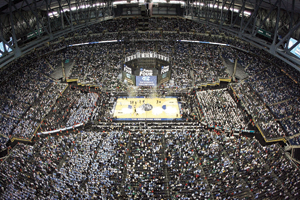Amongst the madness of March each year (as
fellow contributor Kevin Murray discussed yesterday), it’s easy for the big
business of the Big Dance to go unnoticed. High-level sponsors and multibillion
dollar broadcast deals make the Men’s NCAA Basketball Tournament one of the
biggest draws in sport. Here are some trends that affect the future of the Big
Dance:
 Michael
Smith of SBJ discusses the major innovations that set this sport behemoth
in motion. The most major of these changes involve the Final Four, the last
three games of the tournament that have grown from simple athletic contest to a
cultural and entertainment mega event. The event was moved to prime time on
Saturday and Monday nights in 1973 (to generate the largest TV audience
possible). In 2009, the NCAA moved the court from one end of the dome to the
center, allowing more than “70,000 fans to witness the championship game each
year.” When Coca-Cola became one of the NCAA’s highest-level sponsors in 2002,
they wanted to create an event on the Sunday between the semifinal and National
Championship game. Started in 2003, this event has now grown to a three-day
festival of music during Final Four weekend, each day sponsored by a different
NCAA champion sponsor.
Michael
Smith of SBJ discusses the major innovations that set this sport behemoth
in motion. The most major of these changes involve the Final Four, the last
three games of the tournament that have grown from simple athletic contest to a
cultural and entertainment mega event. The event was moved to prime time on
Saturday and Monday nights in 1973 (to generate the largest TV audience
possible). In 2009, the NCAA moved the court from one end of the dome to the
center, allowing more than “70,000 fans to witness the championship game each
year.” When Coca-Cola became one of the NCAA’s highest-level sponsors in 2002,
they wanted to create an event on the Sunday between the semifinal and National
Championship game. Started in 2003, this event has now grown to a three-day
festival of music during Final Four weekend, each day sponsored by a different
NCAA champion sponsor.
Some future trends that will positively impact the value of
the NCAA Tournament include improved LED courtside signage and more courtside seating,
as well as increasing the use of mobile devices and other technology to expand
the viewership of the tournament. There has also been talk of moving the Final
Four back to an arena, instead of exclusively the bowls that have been home to
the tournament since 1997 (per
SportsBusiness Journal).
 David
Haney of SBJ discusses one recent trend that is harming those involved with
the NCAA Tournament; brand degradation. Many schools including Louisville,
UCLA, Baylor, and Notre Dame agreed to wear Adidas’
new short sleeve and camouflage uniforms during postseason play. The consensus
among fans is that the uniforms are unattractive and distracting. Haney argues
that these uniforms are great for Adidas’ brand building, but do little (and
may actually harm) the brands of the partnering schools. In 2012, over 57
million people watched the NCAA Tournament—the latest fad uniforms might
generate some chatter, but over the long term it weakens brand associations
fans have with a specific university (Notre Dame’s jerseys are the most
egregious). This trend flies directly in the face of all brand management best
practices.
David
Haney of SBJ discusses one recent trend that is harming those involved with
the NCAA Tournament; brand degradation. Many schools including Louisville,
UCLA, Baylor, and Notre Dame agreed to wear Adidas’
new short sleeve and camouflage uniforms during postseason play. The consensus
among fans is that the uniforms are unattractive and distracting. Haney argues
that these uniforms are great for Adidas’ brand building, but do little (and
may actually harm) the brands of the partnering schools. In 2012, over 57
million people watched the NCAA Tournament—the latest fad uniforms might
generate some chatter, but over the long term it weakens brand associations
fans have with a specific university (Notre Dame’s jerseys are the most
egregious). This trend flies directly in the face of all brand management best
practices.
Overall, big business has made a great deal of positive impact
on the NCAA Tournament’s business. That being said, not all change (even when
millions of dollars are involved) is positive for the universities and the
athletes involved.


No comments:
Post a Comment